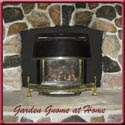We bought this house in September 2011. Within the first two weeks installed a new natural gas range and replaced the dishwasher. Then we left for our vacation home in Florida for three weeks, home long enough to do some unpacking and organizing as well as a bit of home canning then we were back to Florida for most of December. When we returned home, I turned my attention to choosing colours for our new home and repainting a couple of rooms. Although I had plans to repaint all the rooms before spring, that didn't happen but I did get three finished, the guest bedroom, upper level bathroom and kitchen.
The kitchen was painted a cool taupe when we bought the house. A friend of ours is a cabinet maker and finisher so he is doing a lot of custom woodworking for us. He make a shelf for over the sink just to the far left but visible in the last picture. We custom matched the paint for the walls to our dinnerware thanks to our friends at Home Hardware. Once the walls were finished, our friend built in the bulkhead and added trim around the ceiling. We had panel curtains hung. My husband installed a food waste disposal just in time for the busiest part of the canning year. I home can year round but mid-May through mid-October is very busy. The kitchen sat that way through the busy canning season and three trips to our vacation home. I was sick most of January and February so got little done as far as painting and decorating. That changed with March when I was once again on my feet ready to tackle a few new projects.

The existing range hood was about as disgusting as you could get! I took household ammonia to it and still could not get the thing clean. Not only that, when the northerly winds blew there was enough draft coming in the range hood to move the panel curtains. I removed the vent screen, covered it with tin foil then put it back into place just to keep the cold air out. So, I went to Rona Building Centre for a replacement, identical to it except black for $49.99 that was in their flyer to find that it had been discontinued. The search was on.
In fairness, I seldom use a range hood. I had no range hood in our first two houses, a range hood in the third house, no range hood in the fourth but then installed the down draft system on the Jenn-Air range that was also moved to our fifth house. I prefer the down draft system over a range hood but we bought a natural gas range for this house that doesn't have a down draft system. Replacing the range hood, in my mind, was more a matter of aesthetics.
We were restricted as far as size both width from the cabinet width and height due to the way the ceramic tile had been installed. We could not go to a range hood wider than 30 - inches or deeper than 6 - inches. I saw a nice thin line model I really liked but then we would be left with a gap between the tile and the hood. I finally decided on the Broan-NuTone HDN64 Series 30 - inch, 180 CFM 7.5 Sones range hood in black for $79.99. Sones is the measurement of the sound level the unit produces. At 7.5 Sones this model is considerably louder than some higher end models that produce only 0.9 Sones. This model has two fan speeds and two settings for the light brightness controlled by rocker switches. It does have a nice, basic design (black with platinum lettering) that I thought would match well with the kitchen range and blend nicely with the rest of the room.

The new range hood could be installed ducted to the outdoors or non-ducted. It has a damper (included) to prevent cold air from entering when installed ducted. If installed non-ducted, the hood requires an additional charcoal filter sold separately.
The damper was very easy to install on the top of the range hood. My husband removed the knock-out on the top of the range hood then screwed the damper into position with the provided self tapping screws. The baffle plate was slid into place behind the grille on the front of the range hood. The slot where the baffle plate went is just visible to the right side at the top just behind the logo on the front of the range hood.

In order to install the new range hood, my husband turned the power off. Then he removed the old range hood. I washed the area well. I then painted the smaller wall just to make sure there would be no wall showing that didn't match the main wall colour. It took two coats but dried quite quickly. I likely could have skipped this step but just wanted to be sure. As you can see, rather than cut the tile as it should have been, the previous owners didn't. That in itself would have presented a problem had we decided to use a range hood that wasn't as deep, not that it could not have been solved, just it would have been more work to install.

If you look closely you can see how dirty and stained the old range hood was. More importantly the actual baffle was missing on the damper (top of old range hood to the left). This explains why the cold air was pouring in when the wind blew. Under normal use, there is no way the baffle would just go missing so it must have broke off when they removed the range hood to install the tile. Why on earth they replaced the range hood without the baffle on the damper is a mystery but then why they would have reinstalled a range hood in such poor condition is beyond me. It should have been replaced when they did the tiling.
Once the paint was dry to the touch, it was time to install the range hood. My husband carefully placed the range hood in place and made the necessary connections. Then he secured the unit temporarily to test the connections by turning on the power. All was well so he turned off the power, finished securing the range hood and turned the power back on.
The new range hood really looks nice! I used a Sylvania 8W LED bulb (450 lumens) instead of the GE 13W CFL (825 lumens). Essentially, it was like replacing a 60W incandescent bulb with a 50W bulb. We were already saving 47W by using a CFL rather than a 60W incandescent but now we will will be saving another 5W. In this day and age of energy conservation, that is a good savings. I am rather pleased with the light output as well. The range hood light is mainly used as task and occasionally evening lighting.
So, we are one step closer to finishing the kitchen. When our friend installed the bulkhead enclosure, it was more of a taupe tone than golden oak. He is going to redo the cabinets to match. He is also going to cut the extra marble tile we found in the garage to fill the gap under the new dishwasher. That leaves us with replacing the microwave oven, the sink and faucet. With any luck our kitchen will be completely finished in the next month or so.


























